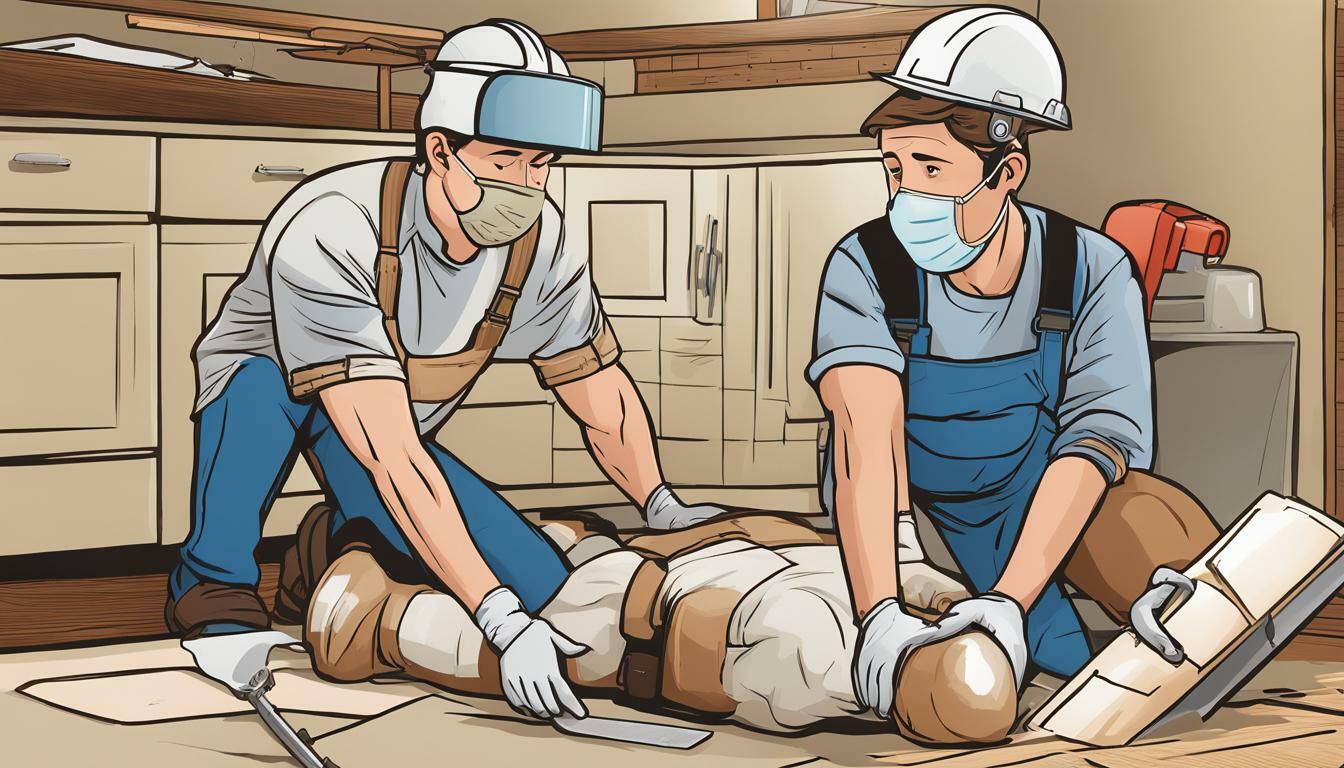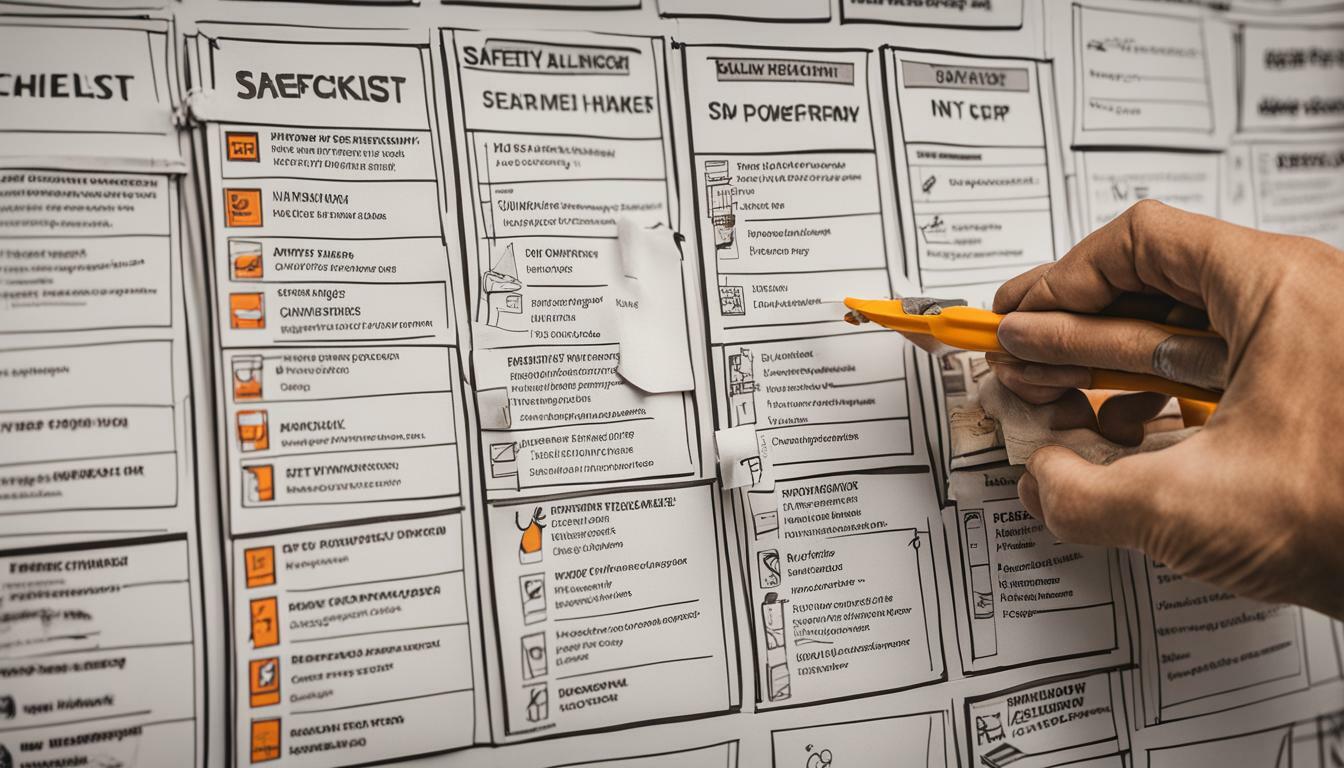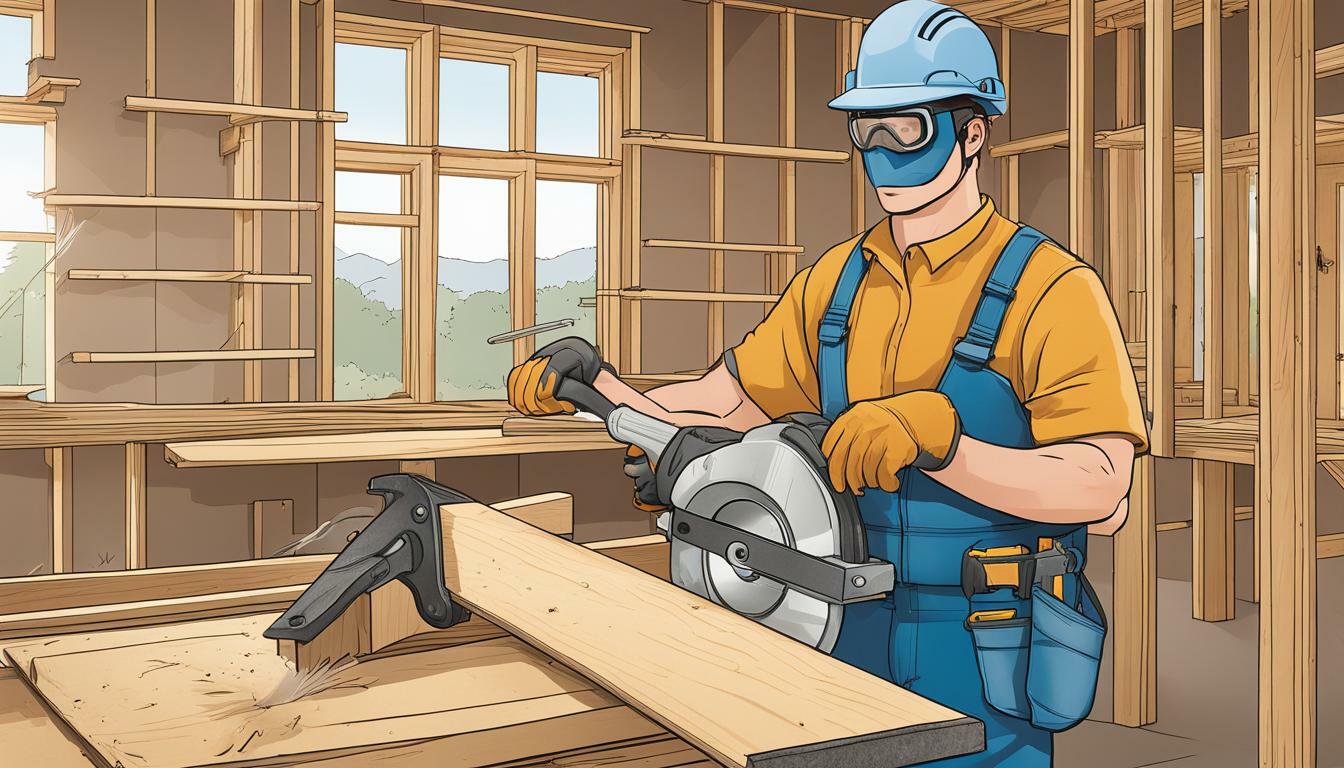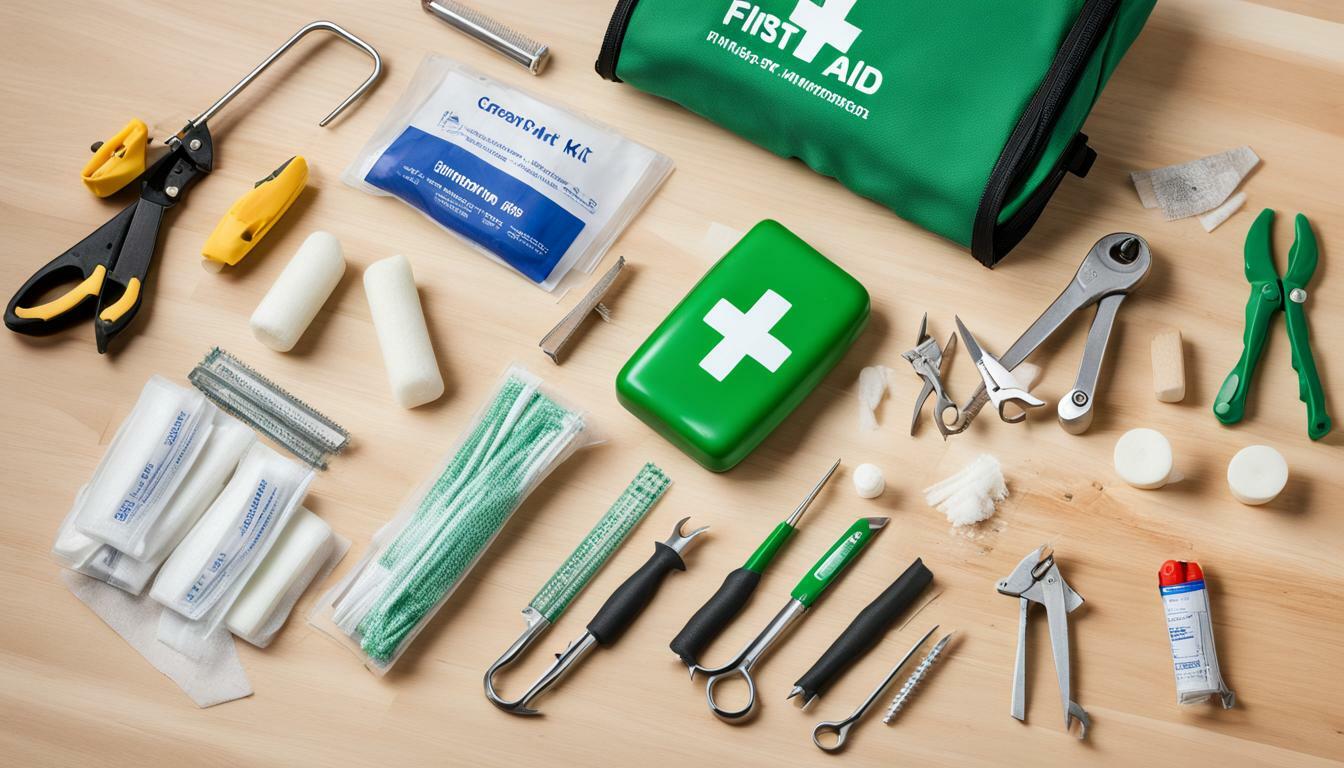Undertaking DIY home improvement projects can be a rewarding experience, but it’s important to take safety seriously. Accidents can happen, and it’s crucial to have the right equipment at hand to deal with them.
One of the most important things to have on hand during any construction project is a proper first aid kit. In this section, we’ll explore the importance of first aid kits for DIY home improvement and construction safety in the UK, and why it’s essential to have the right supplies and equipment to ensure the well-being of all individuals involved in these projects.
Key Takeaways:
- DIY home improvement projects require proper safety measures to prevent accidents and injuries.
- A well-stocked first aid kit is essential for immediate medical assistance in case of accidents.
- Construction-specific first aid kits should include a range of supplies to handle minor cuts and bruises, as well as more severe injuries.
The Importance of First Aid Kits in DIY Home Improvement
DIY home improvement projects can be fun and rewarding, but they also pose potential risks and hazards. It’s crucial to keep a well-stocked first aid kit on hand to ensure that immediate medical assistance can be provided in case of an emergency. Accidents can happen even with the most careful planning and execution of DIY projects.
First aid kits for DIY home improvement should include essential items, such as bandages, plasters, wound dressings, antiseptic wipes, and gloves, to deal with minor cuts and scrapes. However, it’s also important to include equipment to deal with more serious injuries such as burns, eye injuries, or fractures. A well-stocked first aid kit can be the difference between a minor incident and a major emergency.
Construction safety should be a top priority for anyone embarking on a DIY home improvement project. First aid supplies should be given as much attention and importance as other safety equipment like helmets and gloves.

It’s recommended that you purchase a first aid kit designed specifically for DIY construction projects. These kits contain first aid supplies tailored to construction-related injuries and the risks that come with them. They are also designed to be portable, making them easy to carry around on a construction site.
When choosing a first aid kit, it’s essential to ensure that it contains all the necessary supplies and equipment. It should also be easily accessible, so it’s within reach in case of an emergency. Make sure everyone on the construction site knows where the first aid kit is located and how to use it.
In addition to having a well-stocked first aid kit, it’s also essential to have basic first aid knowledge. Anyone working on a DIY construction project should know how to administer basic first aid in case of an emergency. First aid training courses are widely available and can provide invaluable knowledge and skills that can be used in all areas of life.
Construction safety should always be a top priority when working on a DIY home improvement project. By having a well-stocked first aid kit and the necessary safety equipment, you can ensure that you’re prepared for any accidents or emergencies that may occur.
Understanding Construction Safety Risks
DIY home improvement projects can be fun and rewarding, but they also come with significant safety risks. Accidents can happen at any time, and it is important to take measures to prevent them from occurring. Here are some common home construction safety tips to keep in mind:
Falls
Falls are the most common type of DIY construction accident. Falling from a ladder, scaffolding, or roof can cause serious injuries or even death. To prevent falls, make sure to use sturdy and stable equipment when working at heights. Always wear appropriate safety gear such as non-slip shoes and a safety harness when working at heights.
Electrical Hazards
DIYers can be at risk of electrical hazards when working on wiring and other electrical components. To avoid electrocution, always turn off the power before working on any electrical equipment. Use tools with insulated handles and wear rubber-soled shoes to prevent electric shock.
Sharp Tools
Sharp tools such as saws, drills, and nail guns can cause serious injuries if not used correctly. Always read the instructions and follow safety guidelines before using any power tools. Wear appropriate protective gear such as gloves and eye protection when using saws or drills to protect yourself from flying debris.
Chemical Exposure
DIYers may also be exposed to hazardous chemicals when working with paint, solvents, and other chemicals. Always read the labels and follow the recommended safety guidelines when using chemical products. Wear appropriate protective gear such as gloves and a face mask to protect yourself from harmful fumes.
By following these home construction safety tips and taking the necessary precautions, DIYers can minimize the risk of accidents and ensure a safe working environment.

Selecting the Right First Aid Kit for DIY Construction Projects
Choosing the right first aid kit for DIY construction projects is crucial to ensure the safety of workers on site. Having a well-stocked first aid kit on hand can help in providing immediate medical assistance during an emergency. Here are some essential items that must be included in a construction-specific first aid kit:
| Item | Quantity |
|---|---|
| Adhesive bandages (assorted sizes) | At least 30 |
| Gauze pads (assorted sizes) | At least 20 |
| Roller bandages (assorted sizes) | At least 5 |
| Adhesive tape | At least 2 rolls |
| Sterilized eye pads | At least 4 |
| Disposable gloves | At least 4 pairs |
| Scissors | At least 1 pair |
| Tweezers | At least 1 pair |
| Cold packs | At least 2 |
| CPR face shield | At least 1 |
| First aid manual | At least 1 |
It’s important to note that these are only basic items to include in a first aid kit. Your workspace and the nature of the project may require additional supplies. Therefore, it’s essential to have a comprehensive first-aid checklist to ensure that all necessary items are included.

Make sure the first aid kit is always well-stocked, with expiry dates regularly checked, and damaged or used items replaced. Keep the first aid kit in a visible and easily accessible location, free from any obstructions or potential hazards, and ensure that all workers know its exact location.
Safety Equipment for DIY Construction Projects
When it comes to DIY home improvement, safety should always be a top priority. Accidents can happen at any time, and it’s essential to have the right equipment on hand to reduce the risk of injury. Whether you’re a seasoned DIYer or a newcomer to the world of home construction, you should always invest in the right safety gear and equipment to ensure a safe working environment.
Home improvement safety gear can take many forms, but some items are essential for any DIY construction project. Hard hats or helmets are crucial for protecting the head from falling objects, while protective eyewear can protect your eyes from dust, debris, and other hazards. Gloves are also essential for protecting your hands from cuts, burns, and other injuries, while masks can prevent inhalation of harmful particles and chemicals.

When choosing safety equipment, it’s important to consider the specific hazards of your construction project. For example, if you’re working with power tools, ear protection may be necessary to prevent hearing damage. Similarly, if you’re working with chemicals, you may need a full-body suit and respirator to ensure your safety.
Investing in high-quality safety equipment may seem like an unnecessary expense, but it’s a small price to pay for the peace of mind that comes with knowing you’re protected from harm. Plus, in the long run, it can save you money on medical bills and lost workdays due to injury.
First Aid Kit Placement and Accessibility
Proper placement and accessibility of first aid kits are crucial for ensuring quick access to medical supplies and timely response to emergencies during DIY home improvement projects. First aid kits should be kept in a central location that is easily accessible to all workers. It is also essential to ensure that the first aid kit is properly stored and clearly labeled for quick identification.
Consider placing the first aid kit in a visible area and near the project site. Also, make sure that the kit is stored in a dry and cool place to avoid damage to its contents. It’s helpful to have multiple first aid kits in different areas of the construction site, especially large projects with multiple work zones.
Regular restocking of the first aid kit is essential to ensure that it is always ready to use. Keep a first aid checklist handy to track the inventory and expiration dates of each essential item in the kit. This will help ensure that the first aid kit is complete, up-to-date, and fully functional when needed.

In case of an emergency, every second counts, so quick access to a well-stocked first aid kit is critical. By following these guidelines, you can help ensure that your DIY construction project is safe and well-prepared for emergencies with readily available first aid supplies.
First Aid Training for DIY Home Improvement
While having a well-stocked first aid kit and proper safety equipment is essential, it is equally important to have the knowledge necessary to use them effectively in an emergency. That’s why first aid training is a crucial component of DIY home improvement safety.
By acquiring basic first aid skills and certifications, DIYers can respond quickly and effectively to medical emergencies that may occur on construction sites. Training can also increase confidence and help individuals remain calm and composed under pressure, preventing panic from exacerbating an already dangerous situation.

First aid courses vary in length and comprehensiveness, from basic courses that cover CPR and wound care to more intensive courses that include advanced life support and disaster response training. It is essential to select a course that is suitable for the level of risk involved in your DIY project.
Whether online or in-person, first aid training is an investment in the well-being of everyone involved in DIY home improvement projects. By equipping yourself with the necessary skills and knowledge, you can ensure the safety of yourself and those around you.
Additional Safety Measures for DIY Construction Projects
Aside from the use of first aid kits and safety equipment, there are additional safety measures that DIYers should take to minimize the risk of accidents during construction work. By following these guidelines, you can ensure a safe working environment and prevent injuries.
Plan Your Project Ahead of Time
Before beginning any DIY construction project, it is crucial to have a plan in place. This includes developing a timeline for the project, outlining the necessary materials and tools, and establishing safety protocols for yourself and any other individuals involved in the project. By having a clear plan in place, you can minimize the risk of accidents and ensure that the project runs smoothly.
Communicate Effectively
Communication is key when it comes to construction safety. It is important to establish open lines of communication with anyone involved in the project and to ensure that everyone is on the same page regarding safety procedures. This includes discussing potential hazards, identifying safety risks, and ensuring that everyone has a clear understanding of their role in maintaining a safe working environment.
Adhere to Proper Construction Techniques
Proper construction techniques are essential for reducing the risk of accidents during DIY home improvement projects. This includes using appropriate tools and materials, following manufacturer instructions, and adhering to safety guidelines. By following proper construction techniques, you can ensure that your project is completed safely and effectively.
Regularly Inspect and Maintain Tools and Equipment
Regular maintenance and inspection of tools and equipment is crucial for preventing accidents during construction work. This includes checking for damaged or worn tools, ensuring that all equipment is in good working condition, and inspecting the construction site for potential hazards. By regularly inspecting and maintaining your tools and equipment, you can minimize the risk of accidents and ensure ongoing safety.

Stay Informed
Staying informed about construction safety is key to ensuring the well-being of everyone involved in DIY home improvement projects. This includes staying up-to-date on safety regulations and guidelines, reading relevant safety resources, and attending safety training courses. By staying informed, you can take proactive steps to prevent accidents and ensure a safe working environment.
Importance of Regular Maintenance and Inspection
In DIY home improvement projects, regular maintenance and inspection of tools, equipment, and construction sites are crucial to ensure ongoing construction safety and prevent DIY construction accidents. It is essential to identify potential hazards and take measures to minimize them.
One effective way of maintaining construction safety is by conducting regular inspections of tools and equipment. For example, electrical equipment should be inspected for frayed cords or damaged parts before use. Similarly, hand tools should be checked for wear and tear and replaced if necessary. By conducting regular inspections, DIYers can avoid potential accidents and ensure the long-term durability of their tools and equipment.
Another important way to maintain construction safety is by keeping the construction site clean and organized. Cluttered areas can increase the risk of accidents and make it difficult to move around the site. Therefore, it is crucial to periodically remove any debris or objects that could increase the likelihood of tripping, falling or DIY construction accidents.
| Regular Inspections Checklist |
|---|
| 1. Inspect electrical equipment for frayed cords or damaged parts before use. |
| 2. Check hand tools for wear and tear and replace if necessary. |
| 3. Keep the construction site clean and organized by removing debris and objects that could increase the likelihood of tripping or falling. |
By following construction safety best practices, DIYers can minimize the risk of accidents and ensure a safe working environment. Regular maintenance and inspection can help DIYers identify potential hazards and take corrective action before accidents occur. With proper planning, communication, and adherence to safety guidelines, DIYers can enjoy a successful, injury-free DIY home improvement project.

Resources for DIY Construction Safety
Being equipped with the right knowledge and resources is essential to ensuring construction safety during DIY home improvement projects. Here are some valuable resources and references to help you stay informed:
- The Health and Safety Executive (HSE) – The UK government agency responsible for regulating and promoting workplace health and safety standards in all industries, including construction.
- The Construction Industry Training Board (CITB) – Provides training and support for the construction industry, including safety training courses.
- The Royal Society for the Prevention of Accidents (RoSPA) – A UK-based charity that provides information and advice on safety in all areas of life, including DIY home improvement.
- ToolStation – A UK-based retailer that provides a range of safety equipment for DIY projects.
Remember, safety should always be your top priority when engaging in DIY construction projects. By utilizing these resources and incorporating proper safety measures, you can ensure that your DIY home improvement project is a success from start to finish.

Conclusion
DIY home improvement projects can be fulfilling, cost-effective and give you a sense of achievement. However, it is important to prioritize safety and have the appropriate equipment and supplies on hand to prevent accidents.
In this guide, we have emphasized the importance of having a well-stocked first aid kit on DIY construction sites. We have discussed the potential risks and accidents that can occur during construction work and how having the right first aid supplies can help in providing immediate medical assistance.
We have also explored the common safety risks associated with construction work and provided safety tips and guidelines to minimize the occurrence of accidents. In addition, we discussed the importance of safety equipment such as helmets, gloves, protective eyewear, and masks.
Choosing the right first aid kit for DIY construction projects is crucial. We have provided insights into the essential items that should be included in a construction-specific first aid kit, covering everything from major injuries to minor cuts and bruises.
We also mentioned the optimal placement and accessibility of first aid kits on DIY construction sites, and the importance of proper storage and regular restocking.
First aid training is recommended for individuals involved in DIY home improvement projects. We have highlighted the benefits of acquiring basic first aid skills and certifications, enabling DIYers to effectively handle medical emergencies that may arise during construction work.
Finally, we stressed the importance of regular maintenance and inspection of tools, equipment, and construction sites to ensure ongoing safety during DIY home improvement projects. We provided practical tips on how to identify potential hazards and maintain a safe working environment.
